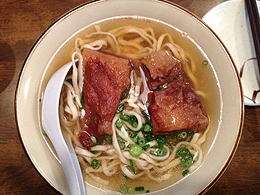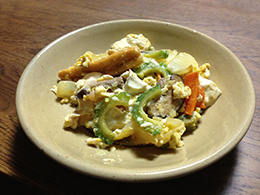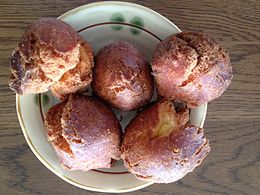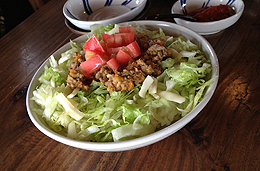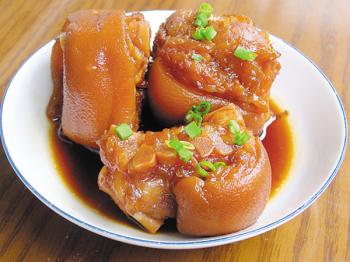Okinawan Food
The roots of modern Okinawan food culture stretch back centuries to the Ryukyu Kingdom, and contain many external influences as well. The islands prospered as a trade hub with mainland Japan, China, and countries of Southeast Asia, and through trade certain aspects of culture were assimilated, and combined to create something entirely new. This is perhaps best embodied by the Okinawan concept of champuru, which means “to blend” or “to fuse.” By combining local ingredients, harvested from the islands and surrounding sea, with both indigenous and adapted cooking techniques, Okinawan cuisine is unlike much of what you will find elsewhere in Japan. (quoted from visitiokinawajapan.com)
Okinawan Soba
This typical Okinawan dish is made from 100% white flour, unlike mainland soba which is made from buckwheat. It is served in a bowl of broth made with bonito and pork and is topped with thick slices of soki (spareribs) or sanmainiku (three-layered pork), a fish paste called kamaboko, and various spices.
Goya Champuru
Goya champuru is the best known among several champuru dishes. Goya, Okinawa’s distinctive bitter cucumber, is rich in vitamins and minerals and is consumed to ward off the suffering brought on by the summer heat.
Saataa Andagi
This is a traditional Okinawan doughnut that is shaped like a tulip. Flour, sugar, and eggs are its main ingredients.
Taco Rice
An icon of Okinawa’s “champuru,” or mixed, culture, taco rice was derived from the Mexican tacos introduced by the American military. Tacos didn’t take off with Okinawans, but they gave birth to taco rice. It is made by placing taco fillings on steamed rice, combining the best of both worlds.
Tebichi
Tebichi, or boiled pig’s feet, is a delicacy peculiar to Okinawa. The pig’s feet are simmered for several hours on low heat, which makes them soft, gelatinous, and easy to eat.




